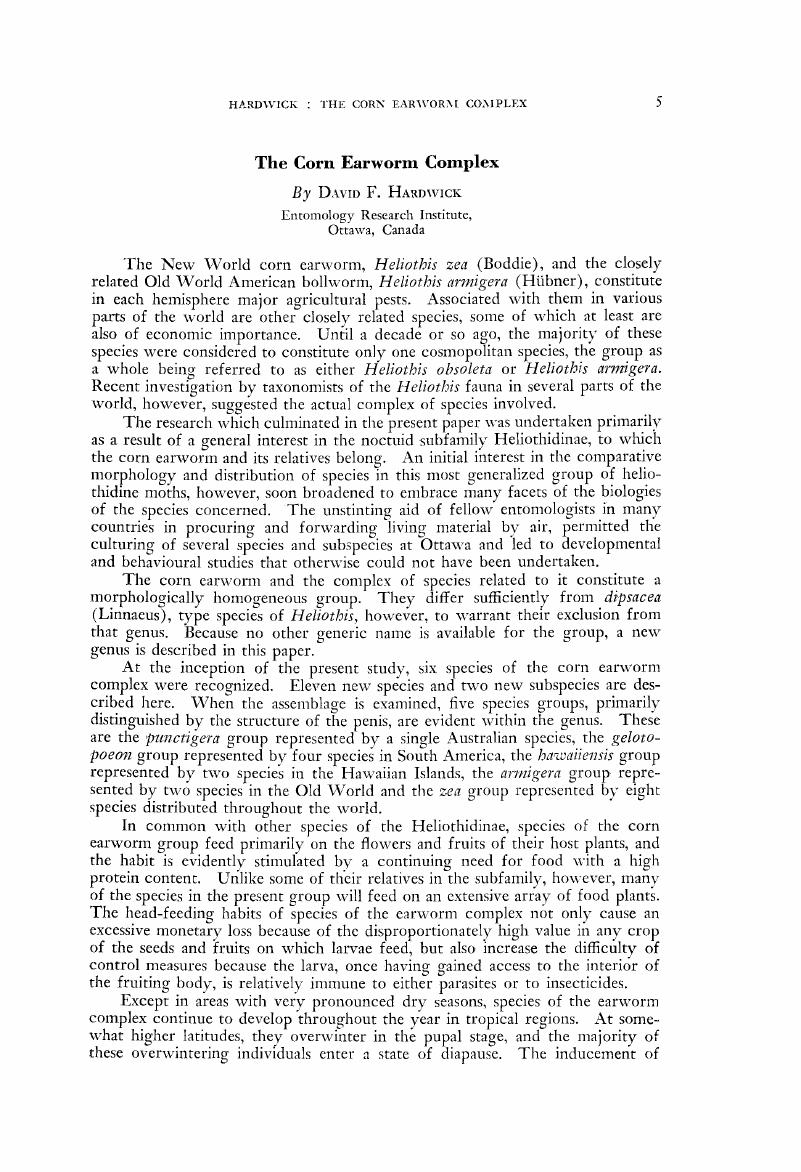Crossref Citations
This article has been cited by the following publications. This list is generated based on data provided by Crossref.
Rao, V. P.
1968.
HeliothisSpp and Their Parasites in India.
International Journal of Pest Management: Part A,
Vol. 14,
Issue. 3,
p.
367.
Hardwick, D. F.
1970.
THE BIOLOGICAL STATUS OF "HELIOTHIS STOMBLERI".
The Canadian Entomologist,
Vol. 102,
Issue. 3,
p.
339.
Proshold, F. I.
and
Bartell, J. A.
1972.
POSTEMBRYONIC GROWTH AND DEVELOPMENT OF F1 AND F2 TOBACCO BUDWORMS (LEPIDOPTERA: NOCTUIDAE) FROM PARTIALLY STERILE MALES.
The Canadian Entomologist,
Vol. 104,
Issue. 2,
p.
165.
Gaugler, R.R.
and
Brooks, W.M.
1975.
Sublethal effects of infection by Nosema heliothidis in the corn earworm, Heliothis zea.
Journal of Invertebrate Pathology,
Vol. 26,
Issue. 1,
p.
57.
Singh, Pritam
1977.
Artificial Diets for Insects, Mites, and Spiders.
p.
287.
Kay, I. R.
1981.
Joint Action of Methomyl and Synthetic Pyrethroids AgainstHeliothis armigeraandHeliothis punctigera.
Tropical Pest Management,
Vol. 27,
Issue. 2,
p.
254.
Bhatnagar, V S
Pawar, C S
Jadhav, D R
and
Davies, J C
1985.
Mermithid nematodes as parasites ofHeliothis spp. and other crop pests in Andhra Pradesh, India.
Proceedings: Animal Sciences,
Vol. 94,
Issue. 5,
p.
509.
Common, I. F. B.
1985.
A NEW AUSTRALIAN SPECIES OF HELIOTHIS OCHSENHEIMER (LEPIDOPTERA: NOCTUIDAE).
Australian Journal of Entomology,
Vol. 24,
Issue. 2,
p.
129.
Raulston, J. R.
Pair, S. D.
Pedraza Martinez, F. A.
Westbrook, J.
Sparks, A. N.
and
Sanchez Valdez, V. M.
1986.
Insect Flight.
p.
204.
Griffith, J. S. R.
and
Haskell, P. T.
1988.
Culture ofHeliothis armigera(Lepidoptera: Noctuidae) using novel group rearing techniques and a semi‐artificial diet.
Tropical Pest Management,
Vol. 34,
Issue. 3,
p.
349.
Abdel-Aal, Yehia A.I.
Hanzlik, Terry N.
Hammock, Bruce D.
Harshman, Lawrence G.
and
Prestwich, Glenn
1988.
Juvenile hormone esterases in two heliothines: Kinetic, biochemical and immunogenic characterization.
Comparative Biochemistry and Physiology Part B: Comparative Biochemistry,
Vol. 90,
Issue. 1,
p.
117.
Singh, A. K.
and
Rembold, H.
1988.
Developmental value of chickpea, Cicer arietinum, soybean, Glycine max, and maize, Zea mays, flour for Heliothis armigera (Lep., Noctuidae) larvae1.
Journal of Applied Entomology,
Vol. 106,
Issue. 1-5,
p.
286.
Gregory, Ben
1989.
Field observations of mating, oviposition, and feeding behavior ofAnticarsia gemmatalis (Lepidoptera: Noctuidae) in a soybean field.
Journal of Insect Behavior,
Vol. 2,
Issue. 6,
p.
761.
Singh, Ashok K.
and
Rembold, Heinz
1989.
Oviposition behaviour of Heliothis armigera (Lepidoptera: Noctuidae) in relation to the day-night cycle.
International Journal of Tropical Insect Science,
Vol. 10,
Issue. 03,
p.
393.
Gregg, P. C.
McDonald, G.
and
Bryceson, K. P.
1989.
THE OCCURRENCE OF HELIOTHIS PUNCTIGERA WALLENGREN AND H. ARMIGERA (HÜBNER) IN INLAND AUSTRALIA.
Australian Journal of Entomology,
Vol. 28,
Issue. 2,
p.
135.
Robinson, Gaden S.
and
Kirke, Charles M.StG.
1990.
Lepidoptera of Ascension Island—a review.
Journal of Natural History,
Vol. 24,
Issue. 1,
p.
119.
Ramaswamy, Sonny B.
1990.
Periodicity of oviposition, feeding, and calling by mated femaleHeliothis virescens in a field cage.
Journal of Insect Behavior,
Vol. 3,
Issue. 3,
p.
417.
Adler, P.H.
Willey, M.B.
and
Bowen, M.R.
1991.
Temporal oviposition patterns of Heliothis zea and Spodoptera ornithogalli.
Entomologia Experimentalis et Applicata,
Vol. 58,
Issue. 2,
p.
159.
HOWARTH, F.G.
and
RAMSAY, G.W.
1991.
The Conservation of Insects and their Habitats.
p.
71.
Singh, A. K.
and
Rembold, H.
1992.
Maintenance of the cotton bollworm, Heliothis armigera Hübner (Lepidoptera: Noctuidae) in laboratory culture — I. Rearing on semi-synthetic diet.
International Journal of Tropical Insect Science,
Vol. 13,
Issue. 03,
p.
333.



